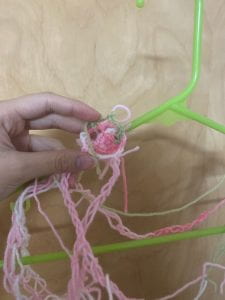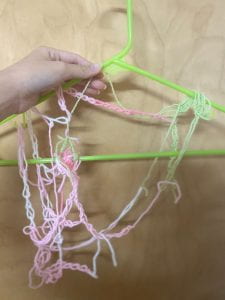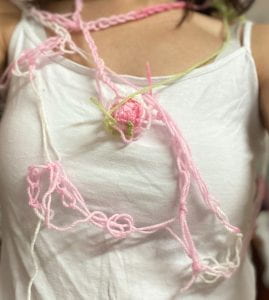Roll the dice.
Crochet the amount of stitches, any type of stitch or knots. Make it loose, make it tight. Wear it.
Choose to connect to any previous stitches, switch yarn, or not.
Start anywhere.
Repeat until the imperfections are gone.



Artist’s Statement:
The idea behind this score is to get the reader comfortable with the idea of human error by physically surrounding them in the messiness of it. Crochet is an art that emphasizes the flaws of human error and portray it in a negative light as it would be obvious amongst the uniform stitches. I strived against this uniformity that is often found within crochet pieces. I wanted to give actors a similar feeling as to when they are a 5-year-old scribbling on a piece of paper without the stress of making sure that they have the right proportions or perspective. It promotes complete creativity from the actors similar to the Happenings as whatever happens, should happen. They are not allowed to unravel the piece and they can only stop once they have come to terms that they are human and mistakes are bound to happen.
I got the idea to use the dice after the first iteration because it’s a randomized way where the user would be pushed to be creative with their piece. When rolling a 1, they can choose the different tension, look, and length that they would like to work with. It also moves the piece away from looking perfect as the idea is to accept the imperfections and the messiness of the piece to end the score. Over all, the score can span for hours, months, or years, which is an inspiration by Yoko Ono as her scores are not always realistic. I wanted to add a deeper meaning to the silliness of her pieces thus, I decided to go with this route for my score.
I look at the result of the piece similar to that of the Happening as well. Whatever happens, would happen to the piece, the crocheter can’t unravel it. It’s similar to a time stamp where it could show the person pausing the piece to have a chat or a sudden knot appearing in the yarn and they haven’t seen it before to unravel it. It makes every iteration of the score unique to the person based on the situations around them. The same person shouldn’t be able to recreate the same exact piece later.
